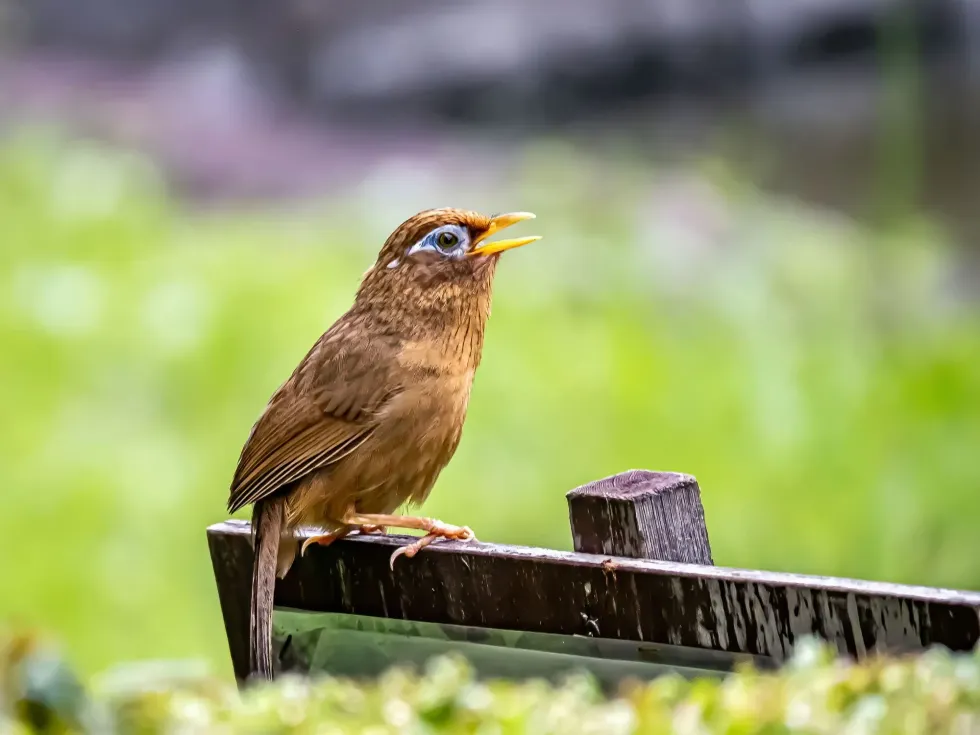The Chinese hwamei (Garrulax canorus) goes by many names. Often referred to as melodious laughing thrush, Chinese thrush, or spectacled jay-thrush, this species is a popular songbird that can be found in many parts of Asia, namely China, Vietnam, Laos, and even Hawaii.
It has been introduced to Taiwan, Japan, Singapore, and Malaysia for the purposes of interbreeding.
This cute little bird is immediately recognizable because of its white spectacles or eye-rings that are referred to as 'painted eyebrows' in China.
Despite its unique physical characteristic, the Chinese hwamei is not easily spotted as it tends to avoid humans and prefers to conceal itself in thickets and shrubs.
Although the bird is listed as a Least Concern species by the IUCN and the range of the bird is quite extensive, the population of the bird is gradually declining due to hunting and illegal trading.
To learn more about the Chinese hwamei, keep reading! If you want to keep learning, do check out some interesting facts and information about the black-throated gray warbler and myrtle warbler.
Chinese Hwamei Interesting Facts
What type of animal is a Chinese hwamei?
The Chinese hwamei (Garrulax canorus) is a species of bird. The animal belongs to the family Leiothrichidae and genus Garrulax.
What class of animal does a Chinese hwamei belong to?
Garrulax canorus (Chinese hwamei) belongs to the Aves class of animals, like the short-eared owl. The scientific names Leucodioptron canorum and Turdus canorus are synonymous with Garrulax canorus.
How many Chinese hwamei are there in the world?
As per the data provided by the Hubei province authority, there exists as many as one to 1.2 million Chinese hwamei (Garrulax canorus). Although the numbers suggest the bird is neither rare nor threatened, the population trend of the species is falling in number due to multiple threats such as hunting, illegal trading, and deforestation.
Where does a Chinese hwamei live?
Garrulax canorus (Chinese hwamei) is native to central and southeastern China, central and northern parts of Vietnam, and northern Laos. The range of this fancy bird is quite extensive in nature as it was introduced in Japan, Taiwan, Peninsular Malaysia, Singapore, and even as far away as Oahu, Kauai, Molokai, Maui, and other Hawaiian islands.
What is a Chinese hwamei's habitat?
Chinese hwamei (Garrulax canorus) can be found living in grasslands, under thick forest undergrowths, thickets, open woodlands, shrubs, reed, and tall grass. The bird prefers to live in wild and exotic forests but due to deforestation and depleting habitats, it has been forced to take refuge in cities.
So, one may even spot them in parks and gardens and even vacant empty lots in urban areas. They typically inhabit areas which as are 5000 ft (1524 m) above sea level.
Who does Chinese hwamei live with?
Chinese hwamei (Garrulax canorus) is socially amicable. They are usually observed in small groups or pairs. However, they do not form group territories or orchestrate cooperative breeding strategies.
How long does a Chinese hwamei live?
The species is a popular caged bird in many parts of the world and it has been observed that the Garrulax canorus (Chinese hwamei) lifespan is up to 12-17 years when in captivity.
How do they reproduce?
The breeding season of Chinese hwamei (Garrulax canorus) begins in March and concludes in August in its native land. In Hawaii, the birds breed from April to July.
They are monogamous and mate for life. Once they have chosen a suitable partner, they get busy building their nests.
The pair works together to build a large, nest on top of trees or bushes that are at least 6 ft (2 m) above the surface. The nests, which are cup-shaped, are made out of grass, roots, reeds, and bamboo leaves. After the nesting is complete the female bird lays two to five eggs.
The eggs are unique and beautiful as they have a blue or bluish-green hue, and sometimes appear to be speckled. The female then proceeds to incubate the eggs for 13-16 days after which the eggs hatch to reveal the chicks.
The nesting period of the baby birds lasts for almost two weeks during which both the parents take turns feeding the chicks. The Chinese hwamei (Garrulax canorus) produces one to two broods per year.
What is the conservation status of Chinese hwamei?
The conservation status of the Chinese hwamei (Garrulax canorus) is evaluated as Least Concern by the International Union for Conservation of Nature or IUCN.
Chinese Hwamei Fun Facts
What does Chinese hwamei look like?
 We've been unable to source an image of a Chinese hwamei and have used an image of a hwamei instead. If you are able to provide us with a royalty-free image of a Chinese hwamei, we would be happy to credit you. Please contact us at hello@kidadl.com.
We've been unable to source an image of a Chinese hwamei and have used an image of a hwamei instead. If you are able to provide us with a royalty-free image of a Chinese hwamei, we would be happy to credit you. Please contact us at hello@kidadl.com.The Chinese hwamei is a medium-sized reddish-brown bird. Its belly is gray in color and it has faint black markings on its head and breast. The crown is pale brown.
The wings are short and the fringes are dark brown in color. The most prominent feature of the species is its white eye-rings which almost look like white spectacles or that they have been painted. The cheek, neck, and throat are light brown. The iris is brown with a yellow-green tinge.
The beak or bill of the species is yellow, as are its legs and claws. Both sexes are similar in their appearance. The fledglings or juveniles have more prominent markings on the upper region of their body.
How cute are they?
These melodious laughing thrush birds are extremely cute in their appearance. Their rich brown body color and striking eyes are instantly eye-catching.
How do they communicate?
This beautiful songbird, Chinese hwamei (Garrulax canorus), uses vocal communication to send messages to their group or pair. These vocalizations become more apparent during the breeding season.
The male sings in a high-pitched and rich tone to attract prospective suitors. Their song includes whistles, harsh notes, warbling, and mimicry of other birds. The female melodious laughing thrush lets out monotone calls when they are near a suitable mate to prompt them to sing and communicate.
How big is a Chinese hwamei?
The Chinese hwamei (Garrulax canorus) is a small songbird that grows up to a length of 8.2-9.4 in (21-24 cm). The melodious laughing thrush is no bigger than the Taiwan hwamei which is also 9.4 in (24 cm) in size. Chinese hwamei birds are bigger than the bee hummingbird which measures up to 2.4 in (6.1 cm) in size.
How fast can a Chinese hwamei fly?
The Chinese hwamei, Garrulax canorus, is a poor flier. The bird has short wings and a medium-sized tail which makes it hard for them to fly long distances. This may be one of the main reasons why the bird does not migrate. Its flight technique includes rapid wing beats and short glides.
How much does a Chinese hwamei weigh?
The Chinese hwamei (Garrulax canorus) is a lightweight bird, it only weighs between 1.7-2.6 oz (49-75 g). However, they are much heavier than the chipping sparrow that weighs between 0.4-0.6 oz (11-16 g).
What are the male and female names of the species?
No specific name has been assigned to the males and females of the species. They are simply referred to as male Chinese hwamei and female Chinese hwamei.
What would you call a baby Chinese hwamei?
The young Chinese hwamei does not have any particular name, it is called a juvenile, chick, or fledgling.
What do they eat?
The Chinese hwamei (Garrulax canorus) is a facultative insectivore but is often forced to follow an omnivorous diet. They feed on insects during the crop season as they are available in plenty during that time of the year.
Once the season has passed they switch to plant seeds. The bird goes foraging among leaf litter for small arthropods, insects, and fruits.
Are they dangerous?
No, the Chinese hwamei or melodious laughing thrush is not dangerous. The species is a popular pet in many parts of the world which proves that the animal poses no threat to man. It is usually the Chinese hwamei that ends up becoming a meal to predators like rats, snakes, and hawks.
Would they make a good pet?
The Chinese hwamei (Garrulax canorus) do indeed make good pets. Bird lovers often adopt this species because not only do they look adorable but a Chinese hwamei song is also sweet and melodious.
However, it's worth mentioning that they are legally protected in many countries since illegal trading of the species is quite rampant. Data suggests that about 1 million birds are kept caged in China and they are sold to various countries.
Did you know...
The Taiwan hwamei was once considered as a subspecies of the Chinese hwamei (Leucodioptron canorum). But now both these animals are considered separate species. Evidence suggests that the two species separated almost 1.5 million years ago.
The Chinese hwamei (Garrulax canorus) can interbreed successfully. The songbird was introduced to Taiwan which has caused hybridization with the Taiwan hwamei.
Why is it called Chinese hwamei?
The Chinese hwamei gets its name from the Chinese character '画眉 ' which is pronounced 'huà-méi'. This means 'painted eyebrow' and is a reference to the distinctive marking around the bird's eyes. The species is very accurately named as its colored or painted eyebrow is its most prominent and proud feature.
What is special about Chinese hwamei?
The Chinese hwamei (Garrulax canorus) is a much sought-after bird because of its unique physical and behavioral characteristics. Its painted eyebrow or white spectacles makes the bird immediately stand out in a group. The sweet and melodious songs of the species added to its allure.
Here at Kidadl, we have carefully created lots of interesting family-friendly animal facts for everyone to discover! For more relatable content, check out these yellow warbler facts and Gyrfalcon facts for kids.
You can even occupy yourself at home by coloring in one of our free printable bird colo




 We've been unable to source an image of a Chinese hwamei and have used an image of a hwamei instead. If you are able to provide us with a royalty-free image of a Chinese hwamei, we would be happy to credit you. Please contact us at hello@kidadl.com.
We've been unable to source an image of a Chinese hwamei and have used an image of a hwamei instead. If you are able to provide us with a royalty-free image of a Chinese hwamei, we would be happy to credit you. Please contact us at hello@kidadl.com.



